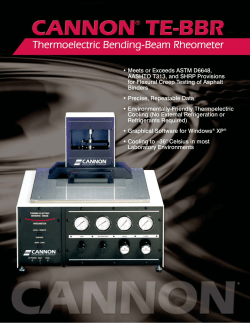
High Temperature Thermoelectric Properties of (1
High Temperature Thermoelectric Properties of (1-x)SrTiO3 – (x)La1/3NbO3 ceramic solid solution Deepanshu Srivastava, F. Azough, R. Freer University Of Manchester, UK INTRODUCTION RESULTS MICROSTRUCTURE Ceramics based on SrTiO3 (STO) are of growing interest as thermoelectric materials because of their high temperature stability and non-toxicity. STO is stable wide band gap semiconductor with a perovskite cubic structure. Doped STO have demonstrated maximum ZT of 0.35 at 1000K[1]. Nanostructuring has limited effect on ZT through grain boundary scattering[2]. Microstructure modification, control of processing conditions can effectively increase the thermoelectric (TE) properties. L(x) were prepared by conventional mixed oxide route for x = 0 to 1 in steps of 0.1. XRD characterisation showed that predominant single phase structure were obtained for x= 0.1, 0.2, 0.3. All compositions were stabilised in cubic symmetry (Pm3m). The lattice parameter increases as shown in inset below. Pore Ti-Nb rich phase La rich phase A second phase develops with increasing sintering time. Line EDS scan on the microstructure reveals Ti-Nb rich phase and Larich core in the grains. Grain size gradually increases with sintering time. [1] Koumoto, K.; Annual Review of Materials Research, Vol 40 2010, 40, 363-394. [2] Yadav, G.G., Nanoscale, 2011, 3, 4078 OBJECTIVES L2 Reduced - 48 hours L1 L2 L3 Vacancy rich column (a) o Study of TE properties of (1-x)SrTiO3 – (x)La1/3NbO3 oStudy of effect of sintering atmosphere on TE properties and microstructure and improve ZT. L1 Reduced L2 Reduced A-site L3 Reduced B-site EXPERIMENTAL METHODOLOGY Based on optimum microstructure - crystal structure, improved density and higher TE values among x=0,0.1,0.2,0.3; L2 was selected for further detailed study. THERMOELECTRIC PROPERTIES vs SINTERING TIME (b) Intensity Sr1-xLax/3Ti1-xNbxO3= Lx is prepared by mixed oxide route using conventional solid state sintering. L(x) is prepared in stoichiometric ratio hence creating A-site vacancy by aliovalent substitution of La3+ on Sr2+. Nb5+ is substituted on Ti4+ sites. Level of doping is optimized for improved TE properties. Charge carrier concentration and improved electrical conductivity can be achieved by reduction of Ti4+ sites to Ti3+ and creation of oxygen vacancies with normal pressure sintering 1nm (c) Distance (a)-TITAN (ChemiStem) HAADF image for L3 showing both A-site and B-site atomic columns. Variation in the intensity indicates random distribution of Sr, La and vacancies in A-site and Ti and Nb in B-sites. (b)-Intensity along A-sites. (c)-Intensity along B-sites. CONCLUSIONS CHARACTERISATION METHODS Electrical conductivity and Seebeck coefficient, are measured by ZEM-III ULVAC. Thermal diffusivity is measured by laser flash method (Netzsch STA 449 C); differential scanning calorimeter is used to measure specific heat capacity. Philips XL 30 and TITAN were used to study the structure in SEM and TEM mode. Author’s Contact Details Position : PhD Candidate, University Of Manchester, UK Email : Deepanshu.Srivastava@manchester.ac.uk Phone No : +44 – 0161 306 2264 o Sr1-xLax/3Ti1-xNbxO3 , where x=0.2, sintered for 48 hours (Ar/H2) has optimized TE properties with a maximum ZT = 0.29 at 1000 K. o TE properties have been shown to improve by control on sintering conditions. o Critical areas are to determine oxygen vacancies, Ti4+ reduction and effective mechanism of second phases. Sintering Time Electrical Resistivity Seebeck Coefficient Thermal Conductivity ZT L2 composition was sintered directly in Ar/H2 for different sintering times to study the effect on TE properties as shown above. Acknowledgements
© Copyright 2025















